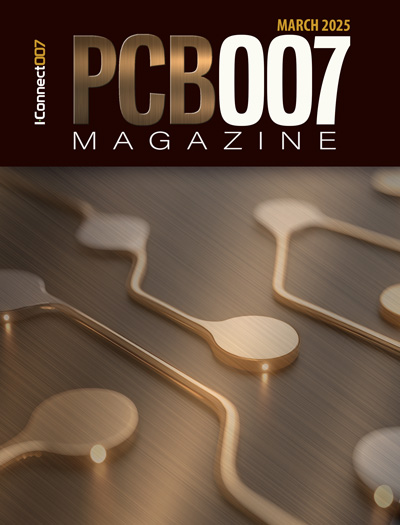-

- News
- Books
Featured Books
- pcb007 Magazine
Latest Issues
Current Issue
Voices of the Industry
We take the pulse of the PCB industry by sharing insights from leading fabricators and suppliers in this month's issue. We've gathered their thoughts on the new U.S. administration, spending, the war in Ukraine, and their most pressing needs. It’s an eye-opening and enlightening look behind the curtain.

The Essential Guide to Surface Finishes
We go back to basics this month with a recount of a little history, and look forward to addressing the many challenges that high density, high frequency, adhesion, SI, and corrosion concerns for harsh environments bring to the fore. We compare and contrast surface finishes by type and application, take a hard look at the many iterations of gold plating, and address palladium as a surface finish.

It's Show Time!
In this month’s issue of PCB007 Magazine we reimagine the possibilities featuring stories all about IPC APEX EXPO 2025—covering what to look forward to, and what you don’t want to miss.
- Articles
- Columns
Search Console
- Links
- Media kit
||| MENU - pcb007 Magazine
Feeling Legs Again Improves Amputees’ Health
September 10, 2019 | ETH ZurichEstimated reading time: 4 minutes
Two volunteers are the first above-knee amputees in the world to feel their prosthetic foot and knee in real time. Their bionic prosthesis, which was developed by an international team of researchers, features sensors that connect to residual nerves in the thigh. The resulting neurofeedback greatly reduces physical and mental strain for users of the prosthesis.
While walking, people with intact legs feel when they move their knee or when their feet touch the ground. The nervous system constantly draws on sensory feedback of this sort to precisely control muscles. People using a leg prosthesis, however, do not know precisely where the prosthesis is located, how it is moving, or what type of terrain it is standing on. They often cannot trust their prosthesis completely when walking, leading them to rely too often on their intact leg, which in turn reduces their mobility and causes them to tire quickly. A simple walk on pebbles or sand, for example, can prove very exhausting for people using a prosthesis. Furthermore, people with amputations can experience phantom limb pain, a condition that existing medications often cannot treat. Savo Panic, who experiences this phenomenon, says he wakes up at night due to the phantom pain: “The toe that I don’t have hurts. My big toe, foot, heel, ankle, calf—they all hurt, and I don’t even have them.”
An international team of researchers led by ETH Zurich and Lausanne-based start-up company SensArs has now developed an interface to connect a leg prosthesis with the residual nerves present in the user’s thigh, thus providing sensory feedback. In a study conducted in collaboration with the University of Belgrade, the scientists tested this neurofeedback system with two volunteers who have an above-knee leg amputation and use a leg prosthesis (one of whom is Panic).
The solution benefited the amputees in a variety of ways, as the researchers reported in the latest issue of the journal Nature Medicine. “This proof-of-concept study shows how beneficial it is to the health of leg amputees to have a prosthesis that works with neural implants to restore sensory feedback,” says Stanisa Raspopovic, a Professor at the Institute of Robotics and Intelligent Systems at ETH Zurich.
Transforming Artificial Signals into Natural Ones
To provide the nervous system with sensory information, the scientists began with a commercially available high-tech prosthesis: they attached tactile sensors to the sole of the prosthetic foot, and collected the data on knee movement provided by the prosthesis’s electronic knee joint.
For the three months that the experiment lasted, surgeons placed tiny electrodes in each volunteer’s thigh and connected them to the residual leg nerves. “The goal of the surgery was to introduce electrodes in the right places inside the nerve to allow the restoration of lifelike sensory feedback, and to allow the stability of the electrodes,” said Marko Bumbasirevic, Professor and orthopaedic microsurgeon at the Clinical Centre of Serbia in Belgrade, who was the clinician responsible for the electrode implant. The electrodes were developed by scientists from the University of Freiburg, and the prosthesis came from the prosthetic company Össur; both were actively involved in the project.
The research team developed algorithms to translate the information from the tactile and motion sensors into impulses of current—the language of the nervous system—which were delivered to the residual nerve. Then nature does the rest: the signals from the residual nerves are conveyed to the person’s brain, which is thus able to sense the prosthesis and helps the user to adjust their gait accordingly. The machine and the body are finally connected.
Less Effort During Walking
As part of the study, the volunteers underwent a series of tests—alternating trials with and without neurofeedback. The results made it very clear just how advantageous the feedback was: walking with neurofeedback was physically much less demanding, as shown by the significant reduction in the volunteers’ oxygen consumption while walking.
Also mentally, ambulation with neurofeedback was less strenuous, as the researchers showed with brain activity measurements during the trials. The volunteers didn’t have to concentrate as hard on their gait, which meant that they were able to devote more of their attention to other tasks.
In one difficult test, the volunteers had to walk over sand, and again the feedback enabled them to walk considerably faster. In surveys, the volunteers stated that the neurofeedback greatly increased their confidence in the prosthesis.
Reduced Phantom Limb Pain
The interface with the nervous system can also be used to stimulate the nerves independently of the prosthesis. Before they started the trial, both volunteers complained of phantom limb pain. Over the course of a one-month therapy programme with neurostimulation, the scientists managed to considerably reduce this pain in one of the volunteers; in the other, Panic, the pain disappeared completely. “Since I have started this treatment programme, after having received electrical stimulations, I don’t feel any phantom pain,” he says.
The scientists view these outcomes optimistically. However, they point out the need for a longer investigation with in-home assessments and a greater number of volunteers, in order to provide more robust data that they can use to draw more significant conclusions. For the time-limited clinical study, the signals from the prosthesis were sent along cables through the skin to the electrodes in the thigh. This meant that the volunteers had to undergo regular medical examinations. To eliminate this need, the scientists intend to develop a fully implantable system. “At SensArs, we’re planning to develop a wireless neurostimulation device that can be fully implanted into the patient like a pacemaker, and that can be brought to the market,” says Francesco Petrini, CEO of SensArs.
Apart from ETH Zurich, the Universities of Belgrade and Freiburg, SensArs and Össur, the project involved scientists from EPFL, the Sant'Anna School of Advanced Studies in Pisa, the University of Montpellier and the company mBrainTrain.
Suggested Items
Laird Thermal Systems Announces Max Kley as New CEO
04/18/2025 | Laird Thermal SystemsLaird Thermal Systems (LTS) is pleased to announce the appointment of Dr. Max Kley as its new Chief Executive Officer, effective April 1, 2025. Max Kley brings a wealth of international leadership experience to LTS, having successfully led and developed businesses across the USA, Europe, and Asia.
ViTrox Marks 25 Years of Innovation with Cutting-Edge Solutions at NEPCON China 2025 in Shanghai
04/18/2025 | ViTrox TechnologiesViTrox, which aims to be the World’s Most Trusted Technology Company, is proud to announce its participation in NEPCON China 2025, taking place from April 22–24, 2025, at Booth #1E45, Shanghai World Expo Exhibition & Convention Centre (SWEECC).
Hanon Systems Wins Third PACE Award for Visible-Light LED Photocatalyst Technology
04/18/2025 | PRNewswireHanon Systems, a leading global automotive thermal management supplier and subsidiary of Hankook & Company Group, has been named a winner of the 2025 PACE Awards. This marks the company's third win, making it the first Korean supplier to achieve this recognition.
Navigating Robotics Deployment Challenges with SINBON
04/18/2025 | PRNewswireIn spite of the potential for robotics technology to expand productivity, several implementation challenges continue to stand in the way of more widespread adoption.
Lam Research Donates Leading-Edge Etch System to Accelerate Nanofabrication R&D at UC Berkeley
04/17/2025 | PRNewswireLam Research Corp. announced the donation of its innovative multi-chamber semiconductor etching system to the Marvell Nanofabrication Laboratory at the University of California, Berkeley to advance research and development (R&D) for next-generation chip technologies.


